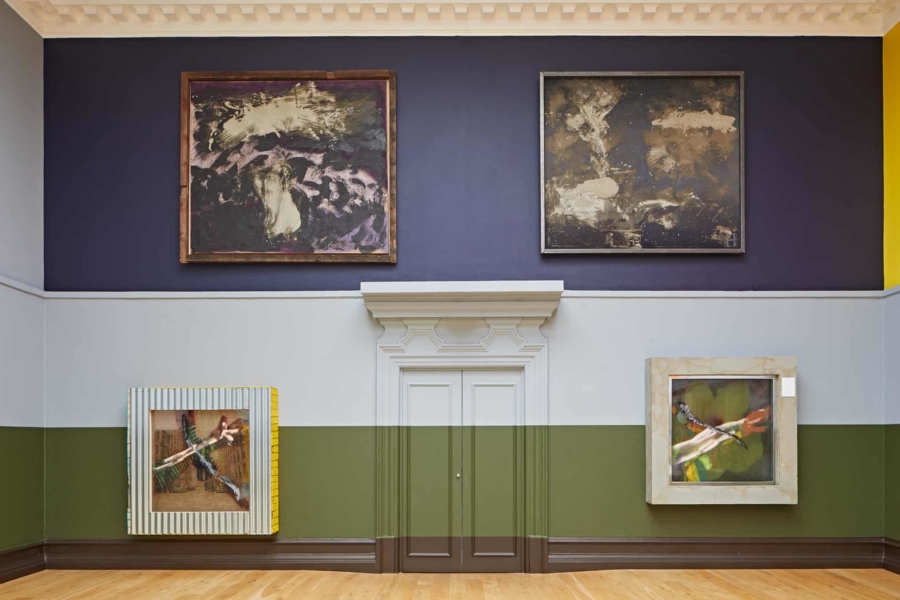October 6, 2021
Download as PDF
View on The Guardian

Bristling with visual references and optical intrigue … Alvaro Barrington at the South London Gallery. Photograph: Andy Stagg
Hanging high on the walls above our heads, paintings of clouds encircle the South London Gallery. There’s weather coming in, growing more and more troubled as we look. Alvaro Barrington has used concrete to paint the clouds, scuffed and trowelled on to gorgeously dyed, high-end Hermès yak wool blankets. As the storm approaches, the support changes to burlap. As much as these paintings might, at a stretch, look back to JMW Turner or to Constable’s cloud studies, abstract expressionism and informalism are in there, too. It is action painting without the angst, unless, that is, you worry about covering luxury blankets with builder’s concrete. This collision of materials, the one despoiling the other, is part of the point of these intemperate paintings, and one of the several ways in which the artist creates his debased and impure art, which attempts to reflect the textures, complexities and inequalities of the modern world.
Born in 1983 in Venezuela to Grenadian and Haitian migrant workers, Barrington grew up in Grenada and Brooklyn. He studied painting in New York and then at the Slade in London, where he currently lives. You never know what he’s going to do or where his art will go next. Artists often used to complain about being “skied” by whoever hung their pictures so far up the wall you couldn’t get a proper view, but clouds are meant to be seen from afar; otherwise, you’re in the fog.
Barrington’s show is less an exhibition of discrete individual works as an installation masquerading as an old-fashioned academy or salon hang. It is a good way of dealing with the SLG’s tall single space, which was completed in 1891, when such curatorial arrangements were common. Barrington has adapted the manners of the 19th-century picture gallery to revel in the complexities of the present and an imagined near-future.
Spider the Pig, Pig the Spider takes as one of its starting points the inequalities of north and south, exacerbated by climate emergency, globalisation and industrialisation. Beneath the clouds, the paintings and drawings that jostle for attention at a more human eye level are presented in cumbersome concrete, aluminium and shiny steel frames. As much architectural devices as frames, redolent of brutalism and corporate high-sheen decor, they give way, on the opposite long wall, to frames of brightly coloured painted wooden slats and corrugated metal. These are meant to remind us of the ad hoc construction work of a poorer south, of cheap building materials and the favella. I’m reminded of Brazilian Tropicália, redone as gaudy poverty chic. Where do the frames end and the paintings begin? They’re all of a piece. Barrington intersperses these cumbersome objects with roughly painted banana leaves.
All of which seems a big step to Peppa Pig and Louise Bourgeois’ gigantic sculpted spider, both of whom are referenced in Barrington’s paintings. These creatures evidence themselves in the pink limbs, cartoonish fingers and trotters, and hairy, grey and black spidery appendages that cross their surfaces. Infant fantasy meets adult darkness, you might say, except there’s no darkness more chilling than that of childhood.
Except it isn’t really Peppa and it isn’t exactly Bourgeois’ Maman either who populate Barrington’s fractious, unruly works. Somehow George Orwell’s Napoleon, the porcine dictator in Animal Farm, and Anansi the Spider from the west African folk tale are in there, too. I worry about the pig and the spider. Are they an item? And then there are the 1980s songs, the riffs on other artists and the autobiographical details that litter Barrington’s multilayered and, at times, confusing art; it has taken me days to get to grips with it.
It is all enough to make you start climbing the walls, which are themselves painted in bands and blocks of flat colour, a kind of colour-coded index of weather and light, pollution sunsets, nightfalls and dawns and grey afternoons.



